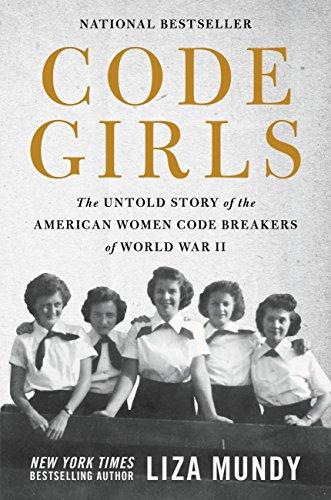Code Girls Summary – Liza Mundy
6 min read ⌚
 The Untold Story of the American Women Code Breakers of World War II
The Untold Story of the American Women Code Breakers of World War II
By now, you are undoubtedly familiar with the name and the legacy of a certain Alan Turing, the guy who cracked the German Enigma ciphers and, thus, shortened the war for about two years and saved at least 14 million lives.
But do you know who operated with the machines who tackled the Enigma ciphers?
Of course you don’t.
Because they were women.
Liza Mundy’s “Code Girls” tells their fascinating story.
Who Should Read “Code Girls”? And Why?
One of the most successful movies from two years ago was “Hidden Figures,” based on Margot Lee Shetterly’s book of the same title published the very same year.
In case you are one of the very few who haven’t watched it, it’s the story of the black female mathematicians who helped NASA win the Space Race with the Soviet Union in the 1960s, an age of racial segregation.
If you liked that film – or the book for that matter – than you’re going to love “Code Girls,” which takes you back two decades to tell you the story of the female code-breakers who helped the U. S. win the Second World War.
Once again – here you’ll find a story of obstacles, intelligence, creative brilliance, triumph and belated remembrance.
And it’s worth every single penny.
 About Liza Mundy
About Liza Mundy
Liza Mundy is an American journalist and non-fiction writer.
She received an AB from Princeton and an MA in English literature from the University of Virginia.
She has authored few books on feminist topics, the most important among them “Michelle: A Biography,” the biography of the former First Lady of the United States, Michelle Obama. Published just last year, “Code Girls” was ranked as one of the ten best science books of 2017 by “Smithsonian.”
In addition, she has also written hundreds of columns and articles for numerous important magazines.
“Code Girls PDF Summary”
Let’s get one thing straight from the start:
Codes have been around for as long as civilization, maybe longer. Virtually as soon as humans developed the ability to speak and write, somebody somewhere felt the desire to say something to somebody else that could not be understood by others. The point of a coded message is to engage in intimate, often urgent communication with another person and to exclude others from reading or listening in. It is a system designed to enable communication and to prevent it.
And in times of war, this type of communication is not merely one way of relaying important messages – it is the only way to do that.
That’s not the only strange thing which happens as soon as a war breaks out.
Among the many negative ones, there’s one which can be tentatively described as “positive”: faced with adversity, some people in power suddenly forget the low opinion they have of other people based on their gender, race, upbringing…
And that’s how some interesting paradoxes occur.
For example, during the 1940s and 1950s, it was all but impossible for most women to get a decent job, and even well-educated ones were encouraged not to have a career; and yet thousands of undergrads were recruited by the Army to crack codes and, thus, care for the well-being of the whole country.
And that’s how the story of “Code Girls” begins.
In the fall of 1941, a select group of undergrads attending the Seven Sister colleges received invitations to one-on-one meetings with senior professors.
They were all asked two questions: do they like doing crossword puzzles, and are they engaged to be married.
The correct answers were “yes” and “no.”
The prize?
Campus training in code breaking with the promise of a civilian government job in Washington once the world is ended.
Thousands took up the offer and ended up spending the war years in Washington, trying to find what the Japanese and the Germans were actually saying under the mumbo-jumbo of the intercepted messages.
It sure looks interesting when you’re watching it on Netflix, but, in actuality, it’s mind-numbingly boring!
Because it means 12-hour days and seven-day workweeks, steamy offices, and bunches and bunches of incomprehensible numbers and letters!
For the women of our story, it was even worse, because sometimes they had to break the code of messages relaying Japanese or German plans to attack regions where their loved ones (brothers or boyfriends) were serving.
It was even worse in reality, because, as Mundy says, “some of the women broke messages warning about attacks before they happened but were helpless to avert them.”
Yet, they found a way through it all, helping the United States win the war not merely by cracking codes, but also by creating phony coded messages to trick the Germans about the site of the D-Day invasion.
Their reward?
Their walking papers and almost nothing more than that.
Not more than a few were the exception, most notable among them Ann Z. Caracristi, an English major at Russell Sage College, who had become the head of an Army research unit already by the age of 23.
After the war, she went on to become the first female deputy director of the National Security Agency.
She died on January 10, 2016, a year before “Code Girls” was published.
Key Lessons from “Code Girls”
1. Thousands of Schoolteachers Changed the Course of the Second World War
2. Some of the Codebreaking Pioneers Were Women
3. The Institutionalization of the Gender Pay Gap
Thousands of Schoolteachers Changed the Course of the Second World War
“Code Girls” is the so far untold story of the thousands of schoolteachers who were drafted by the American Army to break the codes of the Germans and the Japanese and help the United States win the Second World War.
Their mission was top secret, and before Liza Mundy wrote this book, practically nobody knew that such an event ever occurred.
Now, thanks to Mundy’s astounding energy and impressive research skills, we know – and have even preserved first-hand testimonies of some of these women.
Remember some of the names:
Ann Caracristi; Dorothy “Dot” Braden Bruce; Elizabeth Colby; Nan Westcott; Edith Uhe; Gloria Bosetti; Blanche DePuy; Bea Norton; Ann White; Louise Wilde.
Some of the Codebreaking Pioneers Were Women
The women breaking German and Japanese codes during the Second World War weren’t the only women pioneers to be forgotten and practically erased from history.
Take, for example, Agnes Meyer Driscoll, better known as “Miss Aggie” or even “Madame X” who was described by United States Navy rear admiral Edwin T. Layton as “without peer… cryptanalyst.”
That’s because she was exactly that: a leading cryptanalyst for the U. S. Navy from the beginning of the First to the end of the Second World War. She even trained a whole generation of male cryptanalysts.
However, she was constantly patronized and pushed aside – and is today barely remembered.
Driscoll was trained at Riverbank Laboratories, where another woman, Elizabeth Smith Friedman, had founded basically the first facility in the U. S. seriously engaged in studying cryptography. She is today known as “America’s first female cryptanalyst.”
However, she is also known as the wife of the much more famous cryptographer, William Frederick Friedman, even though it seems that she was at least as talented.
The problem oftentimes William was given credit for her work.
The Institutionalization of the Gender Pay Gap
While rummaging through many classified documents, Liza Mundy encountered upon one 1941 Navy memo, according to which female typists and stenographers were supposed to be paid $1,440 per year.
Nothing wrong with that in itself. But many things wrong when you compare this to the salary of men working in the very same posts: $1,620.
Why?
And an even bigger why for the following comparison:
Up until a little more than half a century ago, it seems that it was the law that female Ph. D.s were supposed to be paid about $1,000 dollars less (on a yearly basis) than their male counterparts.
Adjusted for inflation, that amounts to a staggering $10,000 nowadays!
Like this summary? We’d like to invite you to download our free 12 min app, for more amazing summaries and audiobooks.
“Code Girls Quotes”
It was not easy being a smart girl in the 1940s. People thought you were annoying. Share on X
Some of the women broke messages warning about attacks before they happened but were helpless to avert them. Share on X
They did not use the term code breaking outside the confines of the weekly meetings, not even to friends taking the same course. Share on X
Armchair philosophers amused themselves pursuing the perfect cipher, fooling around with clever tables and boxes that provided ways to replace or redistribute the letters in a message, which could be sent as gibberish and reassembled at… Share on X
They mastered the Vigenère square, a method of disguising letters using a tabular method dating back to the Renaissance. They learned about things called the Playfair and Wheatstone ciphers. Share on X
Our Critical Review
Standing at 432 pages, “Code Girls” is a “prodigiously researched and engrossing” book. Considering how important and under-researched topic it grapples with, it couldn’t have been anything less.
The best part is that this book was written just in time so that Mundy isn’t bereaved of the opportunity to interview some of these Code Girls.
We owe Mundy,” wrote Elaine Showalter, “gratitude for rescuing these hidden figures from obscurity. Even more valuable is her challenge to the myth of the eccentric, inspired, solitary male genius, like Alan Turing.
Emir is the Head of Marketing at 12min. In his spare time, he loves to meditate and play soccer.


 The Untold Story of the American Women Code Breakers of World War II
The Untold Story of the American Women Code Breakers of World War II About Liza Mundy
About Liza Mundy




